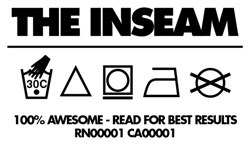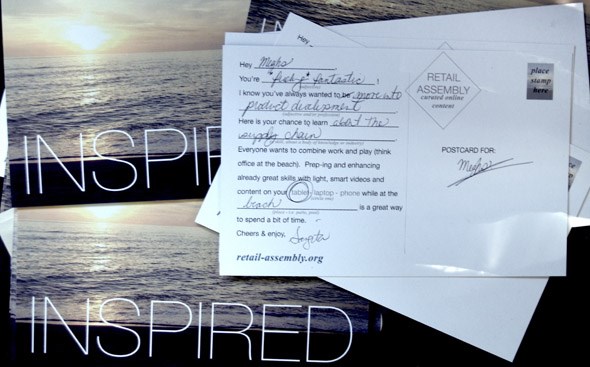 |
Vancouver is home to a thriving fashion industry made up of individuals committed to its growth and success. Get to know these personalities in The Inseam and discover what makes the Vancouver Fashion scene so awesome. |
Photo: courtesy Retail Assembly
Working in the fashion industry can be challenging, especially when you are new to the game or even searching for that missing link in your skill set. Retail Assembly is the latest source of education for those who are seeking a career in fashion, and those who are looking to supplement their knowledge in the field. The website offers a selection of courses and workshops, from Buying to Product Development to Retail Math. Catering to busy schedules, the courses are taught by professionals that are currently active in fashion and creative businesses.
Founder Jennifer Pilkington discusses this innovative model for fashion education and shares her career advice.
Valerie Tiu: Were you always interested in the fashion industry?
Jennifer Pilkington: I wasn’t always interested in fashion but I was always interested in design, colour and shape. When I started at Ryerson, I wasn’t sure that fashion was even the right industry for me because it was so drastically different from all my experiences up to that point. In my second year, I had an internship at Holt Renfrew and when you start working at their corporate offices, it’s really hard not to fall in love with the fashion industry. You have exposure to so much passion and some really great personalities. It was an eye-opening experience.
VT: Where did the concept for Retail Assembly come about?
JP: There were a million little moments that lead to the idea and creation of it. A few months before I started the company, I had frustrating experience after frustrating experience as a manager. I was buying from The Bay at the time and I just couldn’t give my staff and my team a good opportunity for them to learn on the job and progress. There was also a lot going on in terms of learning really niche things. Even when teaching at Ryerson while prepping for the course, looking for content beyond what the textbooks were offering was just really hard to come by. Textbooks are always a little bit stale, not really current or reflective of the marketplace. So I think it was a culmination of all of those things.
Also, seeing students travel absurd distances to come to class once a week and almost everybody works fulltime. It’s really important for us to consider time constraints and flexibility. At some point I realized that it was time to put my feelers out there, so that’s how it all happened.
VT: What kind of courses do and workshops do you offer?
JP: From Vancouver specifically we get a ton of people coming for our Buying and Product Development classes. Retail Math and The Supply Chain have also been really great workshops. Buying, Product Development, Sourcing and Marketing have been heavier courses that take you through the basics and fundamentals. They’re supplemented with case studies, worksheets and quizzes so they are pretty comprehensive.
VT: Tell us about your team of instructors.
JP: Every single course that we have developed has had multiple people touch it. They either provided the content or input. We wanted to ensure that each course reflected the scope of the industry. When I think about what I teach, Fashion Buying, my experience spans the corporate world and bigger companies. I don’t necessarily look at the business the same way that a boutique does.
So by bringing in a lot of people who have worked in the industry to look at each and every course, I think it provides an unbiased view. We have at least one person from the education field to take a look at it, just to make sure that there is structure to it. The people who are working in the industry come from great PR firms, advertising and social media companies. For the buying course, we had people come from boutiques and also corporate levels. I think that’s what makes me so excited about what we’re doing – that everybody who has contributed to the courses is currently working in the industry. It creates room and space for new instructors to come in and contribute. I also tried to use my global network as well because we didn’t necessarily want to keep it Canadian-specific.
VT: Why do you think education is important for people aspiring to work in fashion?
JP: I don’t think it’s the most important thing. But I do think for a lot of people, those job opportunities are not available as quick as you want them, or may be available at all. But I think for people who are in store sales for example, education gives you a base to start from. It will set your resume apart because it shows that you’re serious about a career in fashion.
In an interview if you’ve got some sort of educational background, it will show that you understand concepts and the fundamentals. And when you get the job, you’re already ahead of the game. It’s not the most important thing, but I think it is a great supplement.
VT: What’s the most valuable career advice that you’ve given or received?
JP: Really early on at Holt Renfrew I had this really amazing mentor who said relationships are the most important thing in your professional life. Relationships in terms of having to work for somebody else, collaborating and asking, “What value do you bring to the table?”
VT: What is your most memorable experience working in fashion?
JP: There are so many memorable experiences that would make your jaw drop. I remember going to meet with the designers of Proenza Schouler. I was buying for Holt Renfrew at the time. They just seemed like these two really nice, lovely Canadian guys, but were so bold in their vision. I remember looking at coats for 4000 dollars, when these guys didn’t have a reputation at all in the industry at this point. But they believed so much in who their customer is, their skills, quality and craftsmanship. I just thought it was really ballsy and I was so impressed.
VT: How do you envision the future of Retail Assembly?
JP: We initially picked a name that was bigger than what it was going to be. “Retail” is there so it reflects the industry and we really liked the idea of an assembly, of getting people around the table for a common purpose. Right now we have multiple contributors, so for every course there are five to 15 people touching it. That also includes the people taking the course and participating in the discussion forums.
We have this bigger vision where we hope that down the road it also becomes a showcase for innovation and new ideas. We want people contributing whatever it is they’re doing from an innovation and strategic standpoint. We want to spark ideas. We don’t want to just teach content, we want it to be a source of inspiration and improvement for the industry as well.
http://vimeo.com/64494805



